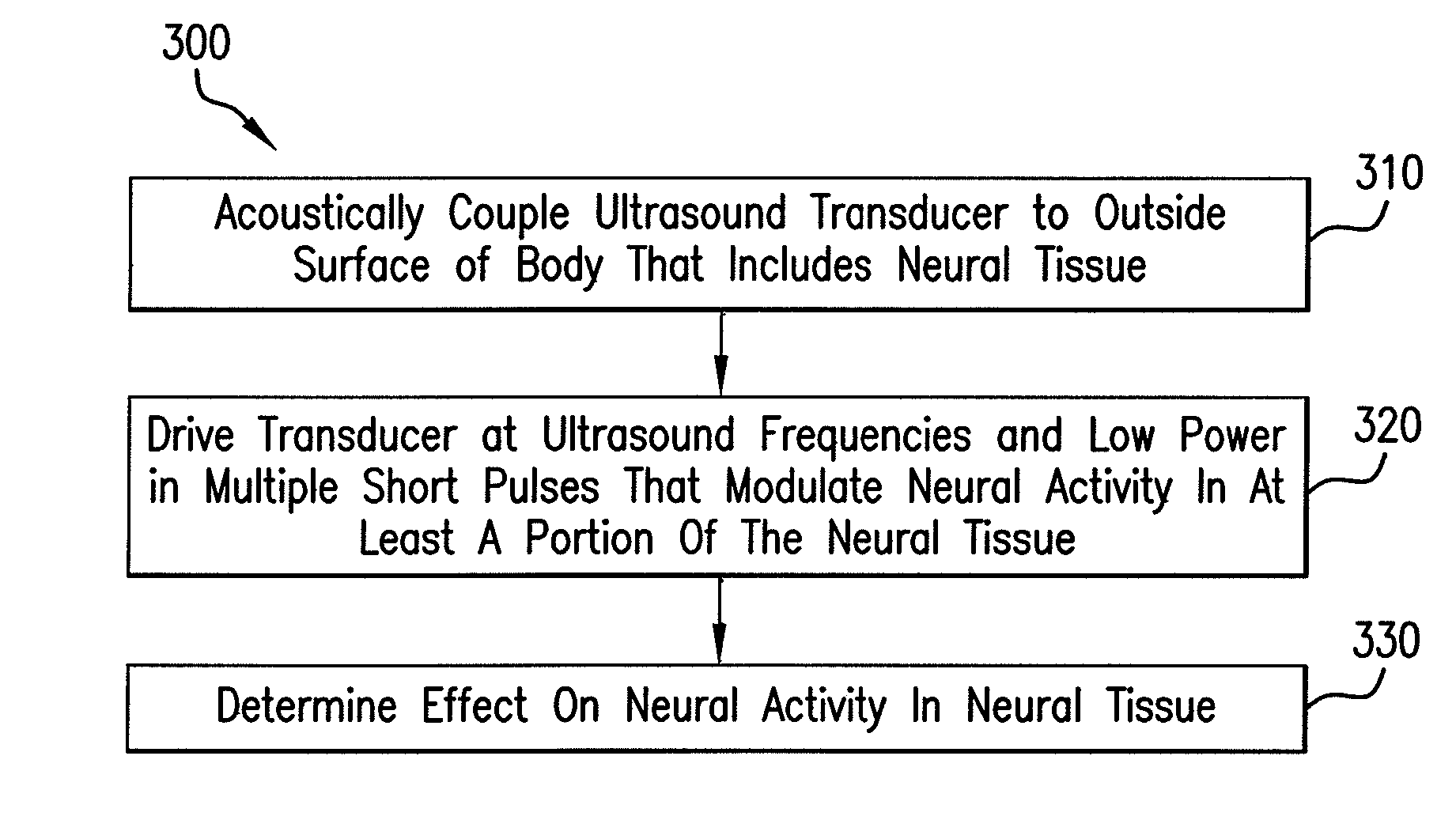Methods and devices for modulating cellular activity using ultrasound
a technology of cellular activity and ultrasound, applied in ultrasonic/sonic/infrasonic diagnostics, applications, therapy, etc., can solve the problems of secondary medical risks, invasive, expensive and even dangerous procedures, and the increase of electrodes
- Summary
- Abstract
- Description
- Claims
- Application Information
AI Technical Summary
Benefits of technology
Problems solved by technology
Method used
Image
Examples
example 1
Quantification of Synaptic Activity in Hippocampal Slice Cultures
[0219]Hippocampal slice cultures were prepared from thy-1-synaptopHluorin (spH) mice. SynaptopHlourin is expressed in both excitatory and inhibitory hippocampal neurons of thy-1-spH mice. Synaptic vesicle release (exoytosis) at an individual release site from these mice is indicated by spH which fluoresces at a particular wavelength (about 530 nm) in the green portion of the optical spectrum when excited by laser light at 488 nm from laser-scanning confocal microscope. The intensity of fluorescent emissions (F) from all sites in view is measured to quantify synaptic activity. ΔF expressed as a percentage indicates percentage changes in total intensity of the fluorescence; and therefore percentage changes in synaptic activity. Synaptic activity is indicated by spH in both a CA1 stratum radiatum (CA1 SR) region and a CA1 stratum pyramidale (CA1 SP) region—the latter a region with a particularly high density of inhibitory...
example 2
Comparison of Effects of Neural Activity Inducement Between Ultrasound and Conventional Means
[0220]To determine whether the effects of ultrasound modulation are comparable to neural activity changes induced by more invasive, conventional means, consider FIG. 6A and FIG. 6B. FIG. 6A is a graph 600 that illustrates comparative temporal responses of neural activity after modulation by electrical impulses and after modulation by an ultrasound waveform, according to an embodiment. The horizontal axis 602 is time in seconds; and the horizontal scale is given by segment 601 that corresponds to 5 seconds. The vertical axis 604 indicates ΔF in percent (%); and the vertical scale is given by segment 605 that corresponds to 10%. The start of USW-1 is indicated by tick 603. Curve 610 indicates the average temporal response from USW-1, from over 148 individual responses, as given by average response 540 in graph 530. Curve 620a indicates the response of spH fluorescence in Schaffer collaterals r...
example 3
Stimulation of SNARE-Mediated Synaptic Vesicle Exocytosis and Synaptic Transmission by Low-Intensity, Low-Frequency Ultrasound
[0226]Changes in membrane tension produced by the absorbance of mechanical energy (e.g., sound waves) alter the activity of individual neurons due to the elastic nature of their lipid bilayers and spring-like mechanics of their transmembrane protein channels. In fact, many voltage-gated ion channels, as well as neurotransmitter receptors possess mechanosensitive properties permitting them to be differentially gated by changes in membrane tension. Therefore, a set of methods for investigating the influence of mechanical energy conferred on neuronal activity by ultrasound were utilized. Using these methods, it was found that pulsed ultrasound is capable of stimulating SNARE-mediated synaptic transmission, as well as voltage-gated sodium (Na+) and (calcium) Ca2+ channels in central neurons. SNARE proteins are a class of proteins that include neuronal Synaptobrev...
PUM
 Login to View More
Login to View More Abstract
Description
Claims
Application Information
 Login to View More
Login to View More - R&D
- Intellectual Property
- Life Sciences
- Materials
- Tech Scout
- Unparalleled Data Quality
- Higher Quality Content
- 60% Fewer Hallucinations
Browse by: Latest US Patents, China's latest patents, Technical Efficacy Thesaurus, Application Domain, Technology Topic, Popular Technical Reports.
© 2025 PatSnap. All rights reserved.Legal|Privacy policy|Modern Slavery Act Transparency Statement|Sitemap|About US| Contact US: help@patsnap.com



